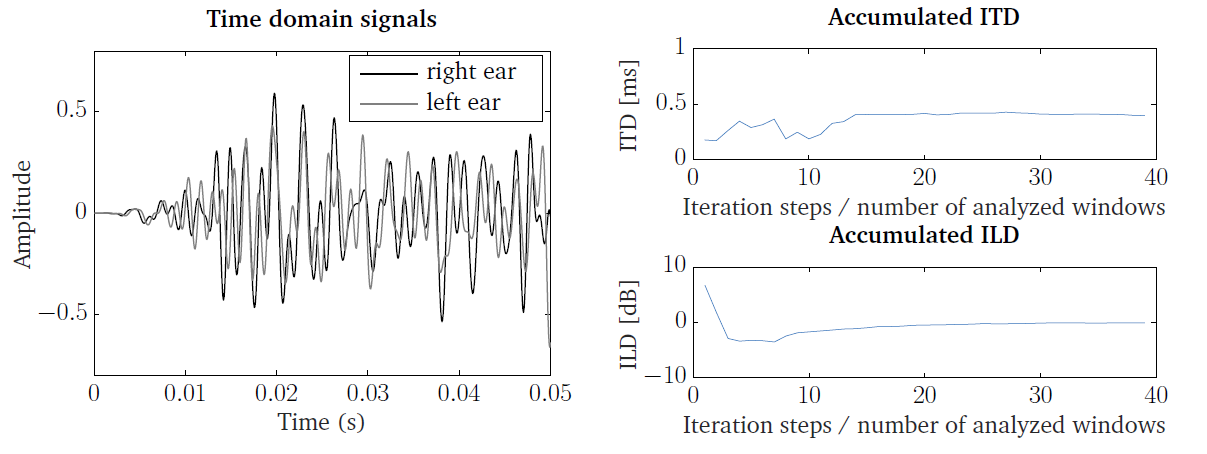Precedence effect (precedenceProc.m)¶
The precedence effect describes the ability of humans to fuse and localize the sound based on the first-arriving parts, in the presence of its successive version with a time delay below an echo-generating threshold [Wallach1949]. The effect of the later-arriving sound is suppressed by the first part in the localization process. The precedence effect processor in Auditory front-end models this, with the strategy based on the work of [Braasch2013]. The processor detects and removes the lag from a binaural input signal with a delayed repetition, by means of an autocorrelation mechanism and deconvolution. Then it derives the ITD and ILD based on these lag-removed signals.
The input to the precedence effect processor is a binaural time-frequency signal chunk from the gammatone filterbank. Then for each chunk a pair of ITD and ILD values is calculated as the output, by integrating the ITDs and ILDs across the frequency channels according to the weighted-image model [Stern1988], and through amplitude-weighted summation. Since these ITD/ILD calculation methods of the precedence effect processor are different from what are used for the Auditory front-end ITD and ILD processors, the Auditory front-end ITD and ILD processors are not connected to the precedence effect processor. Instead the steps for the correlation analyses and the ITD/ILD calculation are coded inside the processor as its own specific techniques. Table 34 lists the parameters needed to operate the precedence effect processor.
| Parameter | Default | Description |
|---|---|---|
prec_wSizeSec |
20E-3 |
Window duration in s |
prec_hSizeSec |
10E-3 |
Window step size in s |
prec_maxDelaySec |
10E-3 |
Maximum delay in s for autocorrelation computation |
Fig. 41 shows the output from a demonstration script
DEMO_precedence.m. The input signal is a 800-Hz wide bandpass noise of 400
ms length, centered at 500 Hz, mixed with a reflection that has a 2 ms delay,
and made binaural with an ITD of 0.4 ms and a 0-dB ILD. During the
processing, windowed chunks are used as the input, with the length of 20 ms. It
can be seen that after some initial confusion, the processor estimates the
intended ITD and ILD values as more chunks are analyzed.

Fig. 41 Left panel: band-pass input noise signal, 400 ms long (only the first 50 ms is shown), 800 Hz wide, centered at 500 Hz, mixed with a reflection of a 2-ms delay, and made binaural with an of 0.4 ms ITD and ILD of 0 dB. Right panel: estimated ITD and ILD shown as a function of time frames.
| [Braasch2013] | Braasch, J. (2013), “A precedence effect model to simulate localization dominance using an adaptive, stimulus parameter-based inhibition process.” The Journal of the Acoustical Society of America 134(1), pp. 420–35. |
| [Stern1988] | Stern, R. M., Zeiberg, A. S., and Trahiotis, C. (1988), “Lateralization of complex binaural stimuli: A weighted-image model,” The Journal of the Acoustical Society of America 84(1), pp. 156–165, http://scitation.aip.org/content/asa/journal/jasa/84/1/10.1121/1.396982. |
| [Wallach1949] | Wallach, H., Newman, E. B., and Rosenzweig, M. R. (1949), “The Precedence Effect in Sound Localization,” The American Journal of Psychology 62(3), pp. 315–336, http://www.jstor.org/stable/1418275. |